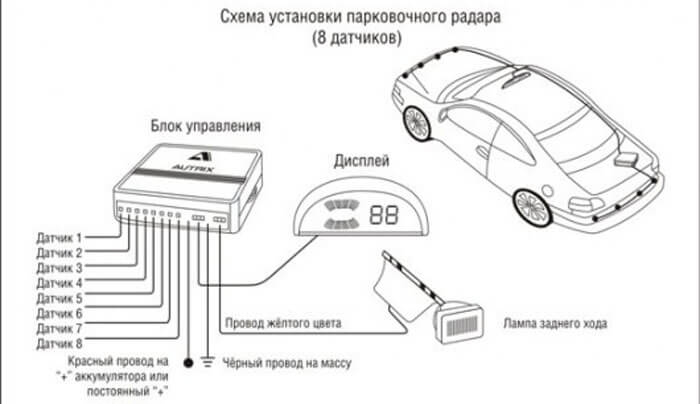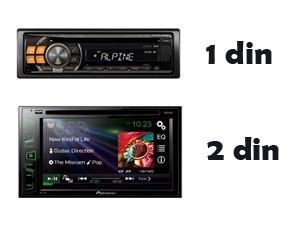
Reversing sensors - how to choose and install?
Content
Reversing sensors are a great solution for people who want to make it easier to park in tight city lanes while increasing their level of safety. Not everyone is aware that parking sensors can be installed on a car that was not equipped with it at the factory. Moreover, in many cases it can be done independently without visiting a car repair shop.
How to equip a car with a reverse sensor?
Anyone who has ever used them in a crowded parking lot knows that reverse sensors are a useful element of car equipment. Perhaps some drivers regard this convenience as a solution for people who are not well versed in parking. However, in fact, even experienced drivers benefit from the presence of sensors. They allow you to safely approach an obstacle in the shortest distance - a distance that the driver cannot correctly estimate while sitting in the car seat.
The automotive market today allows you to install parking sensors on almost any car, even one that the manufacturer did not provide for the installation of such amenities. The matter is simple - we select the necessary reverse sensors with a mounting kit, buy and install according to the instructions.
How do parking sensors work?
The principle of operation of reverse sensors is simple. When a vehicle approaches an obstacle, their job is to detect the obstacle, calculate the distance, and then report it to the driver. The information can be transmitted by an acoustic signal or by a display that graphically shows the remaining distance. The sound of the signal changes as it approaches the obstacle - at first it is interrupted, and at an extremely small distance it changes to continuous, informing the driver about the threat. Parking sensors are most often mounted at the rear of the car, but nothing prevents the front sensors from being installed, which can be useful, for example, when parking at high curbs or when parallel parking.
Types of reverse sensors - which one to choose?
Currently, the market choice of reversing sensors for cars is very wide. In fact, it is up to us, our needs and our wallet, what type of sensors we want to choose. At our disposal:
- parking sensors with audible signal
- parking sensors with sound signal and display
- parking sensors with audible signal and parking assistance
- parking sensors with horn and rear view camera
- wireless reversing sensors
- Reversing sensors without drilling
We can buy the simplest wired set of reversing sensors for a few dozen zł. For a similar product from a well-known manufacturer on the market, we will pay from 100 to several hundred zlotys. However, at a low price, we can also get more comprehensive solutions such as sensors integrated with a rear view camera. The camera, depending on the chosen kit or vehicle body structure, can be placed, for example, in the bumper, in the recess next to the trunk lever or in the license plate frame. The image from the camera will allow us to more accurately assess the threat and the distance to the obstacle. In many cases, this will save our time - traditional sensors react, for example, to obstacles such as tall grass, which are not dangerous for the car in any way. The camera allows us to fully see what type of threat the sensors have detected.
Wireless Reversing Sensors is a solution in which the sensor control unit is connected wirelessly to a display that shows the distance to an obstacle. Therefore, there is no need to wire the control panel to the display. Contrary to the name, these types of sensors are not completely wireless. The sensors in the bumper must be connected to the control unit, which, in turn, must be connected to a power source.
Drillless reversing sensors do not require drilling into the vehicle bumper. Standard solutions require the installation of four or more ultrasonic sensors, which should be placed in the holes drilled in the bumper. The sensors without drilling are based on an electromagnetic solution - a metal tape that must be glued to the inside of the car's bumper. These types of sensors are easier to install but have their drawbacks. These include less range and no function when the car is stationary. This makes it a little more difficult to park in very hard-to-reach places.
Reversing sensors for a car - how to install them?
Installation instructions for reverse sensors vary by product. However, in most cases, we need to start by drilling holes in the bumper to install the sensors (in the case of sensors without drilling, we stick tape instead). First, measure the bumper and mark the location of the sensors with a marker according to the instructions. They must be at the appropriate distance from each other and at the appropriate height. The next step is drilling. For some sensors, a suitable drill is included. If not, we must buy them separately. After preparing the holes, place the sensors in them with the washers and gaskets attached.
The next step is connection. If a display is included with the sensor, we must place it in the appropriate location. This can be, for example, the edge of the roof sheathing above the glass. This arrangement will make it easier to route the cable (in the case of wired sensors) under the headlining to the trunk of the car. The cable from the display is connected to the sensor unit located there, which can be cleverly hidden, for example, under the upholstery of the trunk sidewalls. The control unit must be connected to the car's reverse gear power cord. This will allow the sensors to be triggered when you start reversing. The last step is to connect the sensor cables to the central unit in the appropriate marked order. After the entire procedure, carefully reinstall the ceiling and trunk trim and check the operation of the sensors.
How to check the reverse sensor?
To do this, it is best to conduct the test in a safe environment. Move back to a safe obstacle such as a cardboard box or a polystyrene bag. In the process, we can stop the vehicle and check if the estimated distance to the obstacle by the sensors corresponds to the actual distance to it.
in the Auto section.
